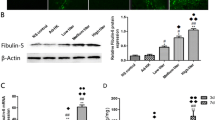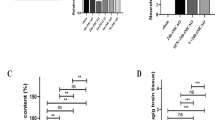Abstract
This study was performed to determine whether recombinant human angiopoietin-1 (Ang-1) decreases the permeability of the blood–brain barrier (BBB) in focal cerebral ischemia and reperfusion rats, whether Ang-1 opens the BBB by affecting tight junction associated proteins zonula occluden-1 (ZO-1), occludin and adherens junction protein vascular endothelial (VE)-cadherin, and whether the protein kinase C (PKC)α/myosin light chain (MLC) signaling pathway involves in it. The rats were divided into eight groups randomly: (1) sham-operated group, (2) ischemia group, (3–5) ischemia–reperfusion (middle cerebral artery occlusion and reperfusion (MCAO/R) 12 h, 48 h, and 7 days) and 0.9% saline groups, (6–8) ischemia–reperfusion (MCAO/R 12 h, 48 h, and 7 days) and Ang-1 groups. The BBB permeability was assessed by Evans blue extravasation. The messenger RNA and protein expressions of ZO-1, occludin, and VE-cadherin were determined by reverse transcription-polymerase chain reaction, western blot, and immunohistochemistry assays. The BBB permeability was significantly decreased after Ang-1 injection. The expressions of ZO-1, occludin, and VE-cadherin were increased after Ang-1 injection. These were in accordance with the results of immunohistochemistry assays. PKCα and phosphorylated MLC (p-MLC) expressions were decreased after Ang-1 injection. This study demonstrated that Ang-1 may decrease the permeability of BBB in MCAO/R rat by upregulation of ZO-1, occludin, and VE-cadherin. The decreased expressions of PKCα and p-MLC induced by Ang-1 also involved in this process.








Similar content being viewed by others
Abbreviations
- BBB:
-
blood–brain barrier
- Ang-1:
-
angiopoietin1
- TJ:
-
tight junction
- AJ:
-
adherens junctions
- ZO-1:
-
zonula occludin 1
- VE-cadherin:
-
vascular endothelial cadherin
- MLC:
-
myosin light chain
- p-MLC:
-
phosphorylated myosin light chain
- TTC:
-
2,3,5-triphenyltetrazolium chloride
- CCA:
-
common carotid artery
- ICA:
-
internal carotid artery
- ECA:
-
external carotid artery
- MCAO:
-
middle cerebral artery occlusion
- MCAO/R:
-
middle cerebral artery occlusion and reperfusion
- PBS:
-
phosphate-buffered saline
- Tris:
-
tris(hydroxymethyl) aminomethane
- rCBF:
-
regional cerebral blood flow
- RT-PCR:
-
reverse transcription polymerase chain reaction
References
Aiello LP, Bursell SE, Clermont A, Duh E, Ishii H, Takagi C, Mori F, Ciulla TA, Ways K, Jirousek M, Smith LE, King GL (1997) Vascular endothelial growth factor-induced retinal permeability is mediated by protein kinase C in vivo and suppressed by an orally effective beta-isoform-selective inhibitor. Diabetes 46:1473–1480
Astrup J, Symon L, Branston NM, Lassen NA (1977) Cortical evoked potential and extracellular K+ and H+ at critical levels of brain ischemia. Stroke 8:51–57
Baldwin AL, Thurston G (2001) Mechanics of endothelial cell architecture and vascular permeability. Crit Rev Biomed Eng 29:247–278
Belayev L, Busto R, Zhao W, Ginsberg MD (1996) Quantitative evaluation of blood–brain barrier permeability following middle cerebral artery occlusion in rats. Brain Res 739:88–96
Bounds JV, Wiebers DO, Whisnant JP, Okazaki H (1981) Mechanisms and timing of deaths from cerebral infarction. Stroke 12:474–477
Cheng YD, Al-Khoury L, Zivin JA (2004) Neuroprotection for ischemic stroke: two decades of success and failure. NeuroRx 1:36–45
Choi HS, Ko YG, Lee JS, Kwon OY, Kim SK, Cheong C, Jang KH, Kang SA (2010) Neuroprotective effects of consuming bovine colostrum after focal brain ischemia/reperfusion injury in rat model. Nutr Res Pract 4:196–202
Cordeiro AL, Figueiredo A, Tomada I, de Almeida H, Neves D (2010) Characterization of the expression of Ang1, Ang2, and Tie2 in the corpus cavernosum of the rat during aging. Microsc Microanal 16:699–709
Croll SD, Wiegand SJ (2001) Vascular growth factors in cerebral ischemia. Mol Neurobiol 23:121–135
Davis S, Aldrich TH, Jones PF, Acheson A, Compton DL, Jain V, Ryan TE, Bruno J, Radziejewski C, Maisonpierre PC, Yancopoulos GD (1996) Isolation of angiopoietin-1, a ligand for the TIE2 receptor, by secretion-trap expression cloning. Cell 87:1161–1169
Ding YH, Luan XD, Li J, Rafols JA, Guthinkonda M, Diaz FG, Ding Y (2004) Exercise-induced overexpression of angiogenic factors and reduction of ischemia/reperfusion injury in stroke. Curr Neurovasc Res 1:411–420
Gamble JR, Drew J, Trezise L, Underwood A, Parsons M, Kasminkas L, Rudge J, Yancopoulos G, Vadas MA (2000) Angiopoietin-1 is an antipermeability and anti-inflammatory agent in vitro and targets cell junctions. Circ Res 87:603–607
Garcia JG, Davis HW, Patterson CE (1995) Regulation of endothelial cell gap formation and barrier dysfunction: role of myosin light chain phosphorylation. J Cell Physiol 163:510–522
Guo WP, Wang J, Li RX, Peng YW (2006) Neuroprotective effects of neuregulin-1 in rat models of focal cerebral ischemia. Brain Res 1087:180–185
Hawkins BT, Davis TP (2005) The blood–brain barrier/neurovascular unit in health and disease. Pharmacol Rev 57:173–185
Heiss WD, Huber M, Fink GR, Herholz K, Pietrzyk U, Wagner R, Wienhard K (1992) Progressive derangement of periinfarct viable tissue in ischemic stroke. J Cereb Blood Flow Metab 12:193–203
Hempel A, Lindschau C, Maasch C, Mahn M, Bychkov R, Noll T, Luft FC, Haller H (1999) Calcium antagonists ameliorate ischemia-induced endothelial cell permeability by inhibiting protein kinase C. Circulation 99:2523–2529
Hixenbaugh EA, Goeckeler ZM, Papaiya NN, Wysolmerski RB, Silverstein SC, Huang AJ (1997) Stimulated neutrophils induce myosin light chain phosphorylation and isometric tension in endothelial cells. Am J Physiol 273:H981–H988
Kim I, Kim HG, So JN, Kim JH, Kwak HJ, Koh GY (2000) Angiopoietin-1 regulates endothelial cell survival through the phosphatidylinositol 3′-kinase/Akt signal transduction pathway. Circ Res 86:24–29
Lampugnani MG, Resnati M, Raiteri M, Pigott R, Pisacane A, Houen G, Ruco LP, Dejana E (1992) A novel endothelial-specific membrane protein is a marker of cell–cell contacts. J Cell Biol 118:1511–1522
Lum H, Malik AB (1996) Mechanisms of increased endothelial permeability. Can J Physiol Pharmacol 74:787–800
Maisonpierre PC, Suri C, Jones PF, Bartunkova S, Wiegand SJ, Radziejewski C, Compton D, McClain J, Aldrich TH, Papadopoulos N, Daly TJ, Davis S, Sato TN, Yancopoulos GD (1997) Angiopoietin-2, a natural antagonist for Tie2 that disrupts in vivo angiogenesis. Science 277:55–60
Matucz E, Moricz K, Gigler G, Benedek A, Barkoczy J, Levay G, Harsing LG Jr, Szenasi G (2006) Therapeutic time window of neuroprotection by non-competitive AMPA antagonists in transient and permanent focal cerebral ischemia in rats. Brain Res 1123:60–67
Mehta D, Rahman A, Malik AB (2001) Protein kinase C-alpha signals rho-guanine nucleotide dissociation inhibitor phosphorylation and rho activation and regulates the endothelial cell barrier function. J Biol Chem 276:22614–22620
Miebach S, Grau S, Hummel V, Rieckmann P, Tonn JC, Goldbrunner RH (2006) Isolation and culture of microvascular endothelial cells from gliomas of different WHO grades. J Neurooncol 76:39–48
Nagasawa K, Chiba H, Fujita H, Kojima T, Saito T, Endo T, Sawada N (2006) Possible involvement of gap junctions in the barrier function of tight junctions of brain and lung endothelial cells. J Cell Physiol 208:123–132
Obara K, Ito Y, Shimada H, Nakayama K (2008) The relaxant effect of okadaic acid on canine basilar artery involves activation of PKCalpha and phosphorylation of the myosin light chain at Thr-9. Eur J Pharmacol 598:87–93
Obara K, Mitate A, Nozawa K, Watanabe M, Ito Y, Nakayama K (2010) Interactive role of protein phosphatase 2A and protein kinase C alpha in the stretch-induced triphosphorylation of myosin light chain in canine cerebral artery. J Vasc Res 47:115–127
Onda T, Honmou O, Harada K, Houkin K, Hamada H, Kocsis JD (2008) Therapeutic benefits by human mesenchymal stem cells (hMSCs) and Ang-1 gene-modified hMSCs after cerebral ischemia. J Cereb Blood Flow Metab 28:329–340
Papapetropoulos A, Garcia-Cardena G, Dengler TJ, Maisonpierre PC, Yancopoulos GD, Sessa WC (1999) Direct actions of angiopoietin-1 on human endothelium: evidence for network stabilization, cell survival, and interaction with other angiogenic growth factors. Lab Invest 79:213–223
Qian YR, Lee MJ, Hwang S, Kook JH, Kim JK, Bae CS (2010) Neuroprotection by valproic acid in mouse models of permanent and transient focal cerebral ischemia. Korean J Physiol Pharmacol 14:435–440
Salamanca DA, Khalil RA (2005) Protein kinase C isoforms as specific targets for modulation of vascular smooth muscle function in hypertension. Biochem Pharmacol 70:1537–1547
Sandoval R, Malik AB, Minshall RD, Kouklis P, Ellis CA, Tiruppathi C (2001) Ca(2+) signalling and PKCalpha activate increased endothelial permeability by disassembly of VE-cadherin junctions. J Physiol 533:433–445
Schnittler HJ, Wilke A, Gress T, Suttorp N, Drenckhahn D (1990) Role of actin and myosin in the control of paracellular permeability in pig, rat and human vascular endothelium. J Physiol 431:379–401
Shin HY, Lee YJ, Kim HJ, Park CK, Kim JH, Wang KC, Kim DG, Koh GY, Paek SH (2010) Protective role of COMP-Ang1 in ischemic rat brain. J Neurosci Res 88:1052–1063
Stamatovic SM, Dimitrijevic OB, Keep RF, Andjelkovic AV (2006) Protein kinase Calpha-RhoA cross-talk in CCL2-induced alterations in brain endothelial permeability. J Biol Chem 281:8379–8388
Sun H, Zhao H, Sharpe GM, Arrick DM, Mayhan WG (2008) Effect of chronic alcohol consumption on brain damage following transient focal ischemia. Brain Res 1194:73–80
Suri C, Jones PF, Patan S, Bartunkova S, Maisonpierre PC, Davis S, Sato TN, Yancopoulos GD (1996) Requisite role of angiopoietin-1, a ligand for the TIE2 receptor, during embryonic angiogenesis. Cell 87:1171–1180
Swanson RA, Morton MT, Tsao-Wu G, Savalos RA, Davidson C, Sharp FR (1990) A semiautomated method for measuring brain infarct volume. J Cereb Blood Flow Metab 10:290–293
Thurston G, Suri C, Smith K, McClain J, Sato TN, Yancopoulos GD, McDonald DM (1999) Leakage-resistant blood vessels in mice transgenically overexpressing angiopoietin-1. Science 286:2511–2514
Verin AD, Patterson CE, Day MA, Garcia JG (1995) Regulation of endothelial cell gap formation and barrier function by myosin-associated phosphatase activities. Am J Physiol 269:L99–L108
Verin AD, Gilbert-McClain LI, Patterson CE, Garcia JG (1998) Biochemical regulation of the nonmuscle myosin light chain kinase isoform in bovine endothelium. Am J Respir Cell Mol Biol 19:767–776
Yang T, Roder KE, Bhat GJ, Thekkumkara TJ, Abbruscato TJ (2006) Protein kinase C family members as a target for regulation of blood–brain barrier Na, K, 2Cl-cotransporter during in vitro stroke conditions and nicotine exposure. Pharm Res 23:291–302
Zea M, Zuluaga R (1989) Mercury levels in auxiliary dental personnel in the CES Specialist Center (Sabaneta, Antioquia). CES Odontol 2:47–50
Zhang ZG, Zhang L, Croll SD, Chopp M (2002a) Angiopoietin-1 reduces cerebral blood vessel leakage and ischemic lesion volume after focal cerebral embolic ischemia in mice. Neuroscience 113:683–687
Zhang ZG, Zhang L, Tsang W, Soltanian-Zadeh H, Morris D, Zhang R, Goussev A, Powers C, Yeich T, Chopp M (2002b) Correlation of VEGF and angiopoietin expression with disruption of blood–brain barrier and angiogenesis after focal cerebral ischemia. J Cereb Blood Flow Metab 22:379–392
Zhang Y, Wang L, Li J, Wang XL (2006) 2-(1-Hydroxypentyl)-benzoate increases cerebral blood flow and reduces infarct volume in rats model of transient focal cerebral ischemia. J Pharmacol Exp Ther 317:973–979
Zhao Y, Davis HW (1998) Hydrogen peroxide-induced cytoskeletal rearrangement in cultured pulmonary endothelial cells. J Cell Physiol 174:370–379
Acknowledgment
This work was supported by the Natural Science Foundation of China under contract no. 30800451, no. 30872656, no. 30700861, no. 30670723, and no. 30973079; Scientific and Technological Research Projects in Colleges and Universities of Liaoning Province, no. 2008850; the special fund for Scientific Research of Doctor-Degree Subjects in Colleges and Universities, no. 20092104110015; and Scientific and Technological Planning Projects of Shenyang, no. F10-205-1-37 and no. F10-205-1-22.
Author information
Authors and Affiliations
Corresponding author
Additional information
Hang Yu and Ping Wang have contributed equally to this work.
An erratum to this article can be found at http://dx.doi.org/10.1007/s12031-011-9666-4.
Rights and permissions
About this article
Cite this article
Yu, H., Wang, P., An, P. et al. Recombinant Human Angiopoietin-1 Ameliorates the Expressions of ZO-1, Occludin, VE-cadherin, and PKCα Signaling after Focal Cerebral Ischemia/Reperfusion in Rats. J Mol Neurosci 46, 236–247 (2012). https://doi.org/10.1007/s12031-011-9584-5
Received:
Accepted:
Published:
Issue Date:
DOI: https://doi.org/10.1007/s12031-011-9584-5




